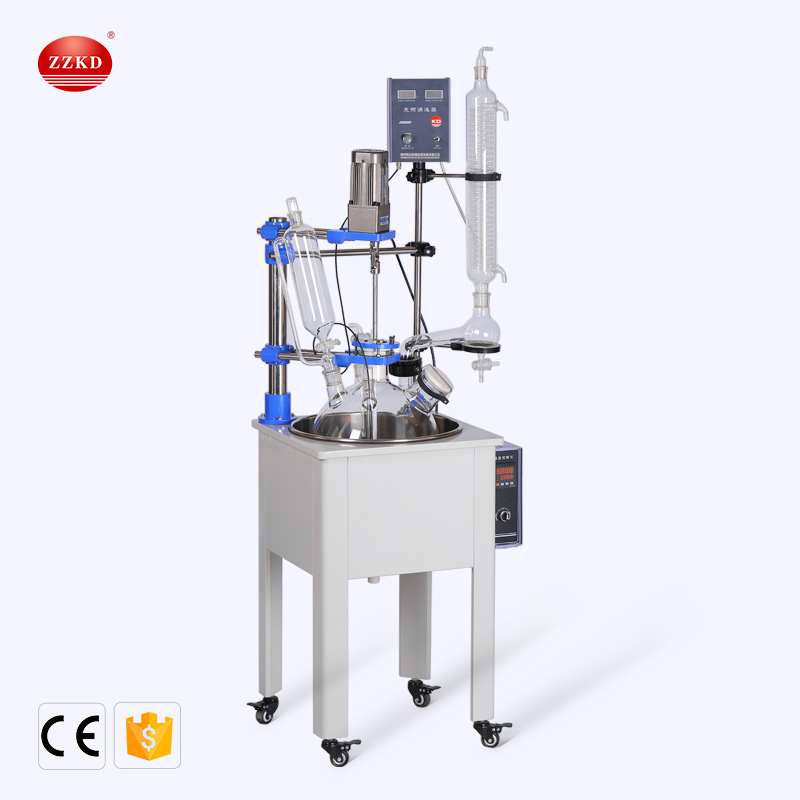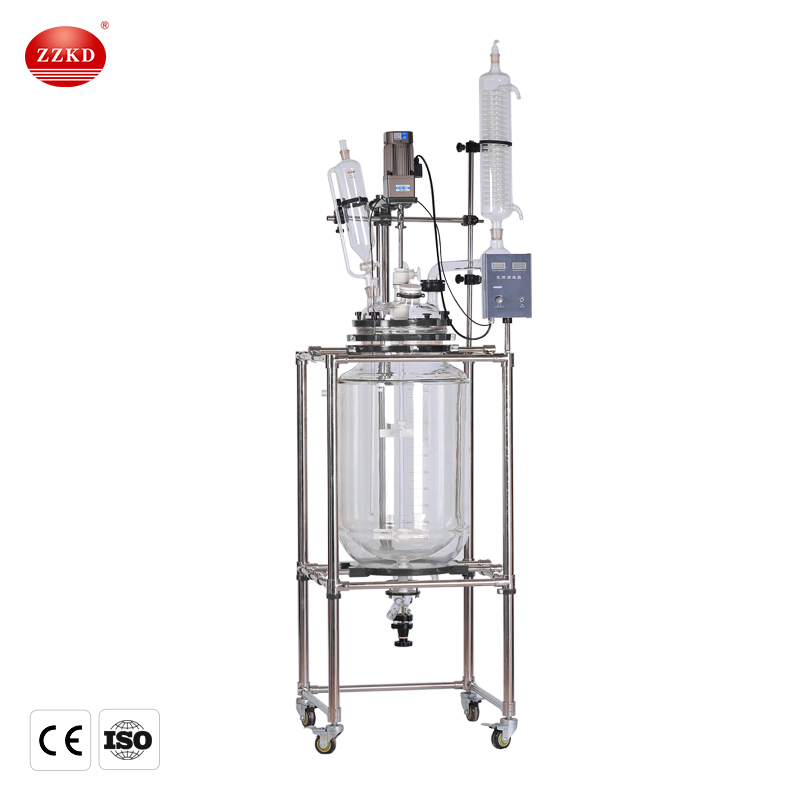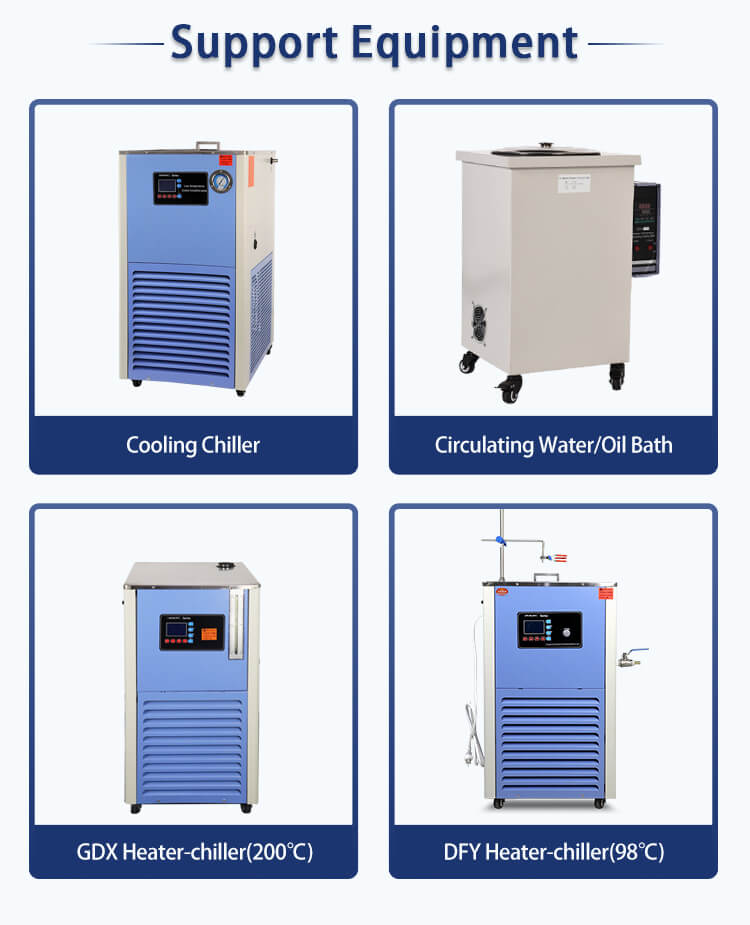Jacketed Glass Reactor Vessel
A 100l glass reactor is a versatile piece of laboratory equipment used for chemical reactions. It consists of a double-layered glass chamber with an outer jacket that allows for precise temperature control during reactions. The transparent design enables real-time observation of reactions, enhancing research accuracy and control. The jacketed glass reactor vessel is commonly used in various fields, including chemistry, pharmaceuticals, and research laboratories.
Introduction for Jacketed Glass Reactor Vessel:
A jacketed glass reactor vessel is a versatile and essential piece of equipment used in various chemical and scientific applications. It consists of a glass vessel with an outer jacket that allows for precise control of temperature during chemical reactions.
The jacketed glass reactor vessel finds extensive use in research laboratories, pharmaceutical development, chemical synthesis, and process optimization. Here are some key applications and benefits of using a jacketed glass reactor vessel:
1. Temperature Control: The outer jacket of the reactor vessel allows for the circulation of temperature-controlling fluids, such as water or oil, providing precise control over the reaction temperature. This enables researchers to conduct reactions at specific temperatures, including low or high temperature ranges, as required by the process.
2. Reaction Monitoring: The transparent nature of the glass reactor vessel allows researchers to visually monitor the progress of reactions in real-time. This visual observation is crucial for studying reaction kinetics, observing color changes, and detecting the formation of precipitates or gas evolution.
3. Safety and Containment: The double-layered design of the jacketed glass reactor vessel provides an additional layer of safety. In the event of a reaction failure or chemical spill, the outer jacket helps contain the hazardous material, preventing its exposure to the external environment and ensuring the safety of laboratory personnel.
4. Versatility: The jacketed glass reactor vessel can accommodate a wide range of chemical reactions, including synthesis, crystallization, distillation, and reflux processes. Its versatility allows researchers to perform various reactions and optimize process conditions for desired outcomes.
5. Scalability: Jacketed glass reactor vessels are available in different sizes, ranging from small-scale laboratory versions to larger industrial-scale reactors. This scalability allows for the seamless transition from laboratory-scale experiments to larger production processes.
Jacketed glass reactor vessels are essential tools for conducting controlled chemical reactions. They offer precise temperature control, real-time observation, safety features, versatility, and scalability, making them invaluable in a wide range of scientific and industrial applications.

Instructions for Use of Jacketed Glass Reactor Vessel
Here are general instructions for using a jacketed glass reactor vessel. It's important to note that specific procedures may vary depending on the equipment model and the nature of the experiment. Always refer to the manufacturer's instructions for your specific jacketed glass reactor vessel.
1. Preparation:
- Ensure the glass reactor vessel and all associated components are clean and free from any residues or contaminants.
- Check that the sealing components, such as O-rings or gaskets, are in good condition and properly installed.
- Prepare the necessary chemicals, solvents, and reactants for the experiment.
2. Setup:
- Place the jacketed glass reactor vessel on a stable surface, such as a laboratory bench.
- Connect the inlet and outlet ports of the jacketed vessel's outer jacket to a temperature-controlling fluid source, such as a circulating bath or chiller, using appropriate tubing.
- Ensure that the fluid circulation is set up correctly and that the temperature-controlling unit is functioning properly.
3. Loading and Assembly:
- Carefully open the reactor vessel and insert the appropriate glassware components, such as stirrers, condensers, and reflux systems, as required for your experiment.
- Securely attach and tighten any necessary clamps or fittings to hold the glassware components in place.
- Add the reactants, solvents, or solutions to the reactor vessel, ensuring not to exceed the maximum volume indicated by the vessel's specifications.
4. Temperature Control:
- Set the desired temperature on the temperature-controlling unit connected to the jacketed vessel's outer jacket.
- Monitor and adjust the temperature as needed during the course of the experiment to maintain the desired reaction conditions.
5. Reaction Monitoring and Control:
- Observe the reaction progress through the transparent walls of the jacketed glass reactor vessel.
- Stir the contents using the built-in stirrer or any other suitable stirring mechanism to ensure proper mixing and reaction kinetics.
- If necessary, adjust other reaction parameters, such as reaction time, reagent additions, or reflux rates, as per your experimental requirements.
6. Completion and Shutdown:
- Once the reaction is complete, carefully remove any glassware attachments or components, taking necessary safety precautions.
- Disconnect the temperature-controlling fluid source from the jacketed vessel's outer jacket and ensure the fluid circulation is stopped.
- Clean the glass reactor vessel and associated components thoroughly following appropriate laboratory protocols.
Always follow proper laboratory safety protocols, including the use of personal protective equipment (PPE) and adherence to chemical handling guidelines, when using a jacketed glass reactor vessel. Consult the manufacturer's instructions and seek guidance from experienced personnel for specific procedures and safety considerations related to your experiment.

100l glass reactor
Supporting Equipment for Jacketed Glass Reactor Vessel :
DLSB-100/30 Refrigerated Circulator
Storage Volume: 100L
Low temperature range: -30℃~RT
Refrigeration capacity: 468~13025W
Rated Power: 4135W
SHZ-C Water Circulating Vacuum Pump
Power: 370W
Flow(L/min): 80
Lift(m): 12
Max.Vacuum(Mpa): 0.098
Tank Capacity: 50L
GYY-100L Refrigerated and Heated Circulating Water Baths
Storage Volume: 100L
Max temperature:200℃
Flow (L/min):20~25
Temperature control range: Water bath: RT~99°C, Oil bath: RT~200°C
Heating power:9000W

The above is Jacketed Glass Reactor Vessel . If you have needs, you can contact Zhengzhou Keda Machinery Equipment Co., Ltd. For decades, Zhengzhou Keda Machinery Equipment Co., Ltd. has been committed to the production and manufacture of laboratory instruments and pipe fittings.
If you want to know about our products, or want to buy our instruments, please feel free to contact us, we will be happy to help you.


